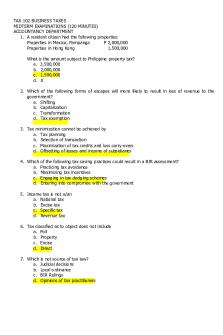Tax Law Tutorial 5 - short answer PDF

| Title | Tax Law Tutorial 5 - short answer |
|---|---|
| Author | T P |
| Course | Taxation Law |
| Institution | University of Technology Sydney |
| Pages | 1 |
| File Size | 78.2 KB |
| File Type | |
| Total Downloads | 40 |
| Total Views | 151 |
Summary
Download Tax Law Tutorial 5 - short answer PDF
Description
Tutorial Week 5 Income I Short Answers 1. ‘Assessable Income’ comprises which types of income? Assessable Income Ordinary Income s6-5 eg. wages, salary
+
Statutory Income s6-10 eg. net capital gain Statutory Income is income that is not ORD Income, but you include it in Assessable Income because of a specific rule in the tax legislation
2. What is not included in assessable income? Exempt Income = AI, but you don’t have to pay tax on it (eg. part-time Army reserve income) Non-Assessable Non-Exempt (NANE) Income = income that you don’t need to pay tax on. It doesn’t affect your tax losses. 3. How does the judicial concept of income differ from the economic concept of income? Judicial concept of income → involves case law - income is determined according to ORD concepts (“ordinary concepts and usages of mankind”) - Scott v CT (1935) 35 SR (NSW) 215 - Judicial concept is another word for “ordinary income” Economic concept of income → Henry Simons - Income = Consumption + Change in Wealth Y = C + ΔW 4. Explain the reconciliation rule on s 6-25 ITAA97. s6-25(2) → reconciliation rule → says that if an amount is both ORD and STAT income, the STAT income rules prevail unless the contrary intention is stated. Alternatively, if an employer provides a fringe benefit to an employee the benefit will be non-AI to the employee (s23L ITAA36) and the employer may be liable to FBT on the value of the benefit. If you have > 1 statutory provision that could apply, take the most appropriate provision. 5. In the case of Federal Coke, which taxpayer should the Commissioner have sought to assess? Explain your reasoning. Federal Coke Co Pty Ltd v FCT (1977) 34 FLR 375. Coke was a subsidiary of Bellambi (parent) Decision: judging the character/nature of the amount in the hands of the recipient (Coke), it was just a windfall gain for Coke. Therefore, not AI → but decision has since been criticised; the argument is that the wrong taxpayer had been assessed, taxpayer should have been Bellambi (the parent). Doctrine of Constructive Receipt → ITAA97 s6-5(4) and 6-10(3) → “you are taken to have received the amount as soon as it is applied or dealt with in any way on your behalf or as you direct” o
-...
Similar Free PDFs

Tutorial 2 Tax Law
- 7 Pages

Tutorial 5 Answer
- 2 Pages

Tutorial 5 - Answer
- 3 Pages

Tutorial 5 law
- 3 Pages

Tax Law Week 8 - Tutorial work
- 4 Pages

Week 5 Ans - tutorial answer
- 9 Pages

Tutorial Answer 5 ( Private Caveat)
- 21 Pages

Inheritance Tax - Short notes
- 5 Pages

Prelim Answer KEY - tax
- 14 Pages

Business TAX MC Answer
- 16 Pages

Midterm exam answer - tax
- 15 Pages

2-2 Short Answer-
- 2 Pages

Short Answer Questions
- 6 Pages
Popular Institutions
- Tinajero National High School - Annex
- Politeknik Caltex Riau
- Yokohama City University
- SGT University
- University of Al-Qadisiyah
- Divine Word College of Vigan
- Techniek College Rotterdam
- Universidade de Santiago
- Universiti Teknologi MARA Cawangan Johor Kampus Pasir Gudang
- Poltekkes Kemenkes Yogyakarta
- Baguio City National High School
- Colegio san marcos
- preparatoria uno
- Centro de Bachillerato Tecnológico Industrial y de Servicios No. 107
- Dalian Maritime University
- Quang Trung Secondary School
- Colegio Tecnológico en Informática
- Corporación Regional de Educación Superior
- Grupo CEDVA
- Dar Al Uloom University
- Centro de Estudios Preuniversitarios de la Universidad Nacional de Ingeniería
- 上智大学
- Aakash International School, Nuna Majara
- San Felipe Neri Catholic School
- Kang Chiao International School - New Taipei City
- Misamis Occidental National High School
- Institución Educativa Escuela Normal Juan Ladrilleros
- Kolehiyo ng Pantukan
- Batanes State College
- Instituto Continental
- Sekolah Menengah Kejuruan Kesehatan Kaltara (Tarakan)
- Colegio de La Inmaculada Concepcion - Cebu


